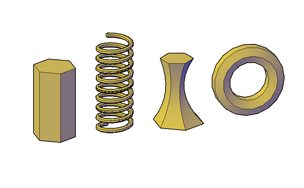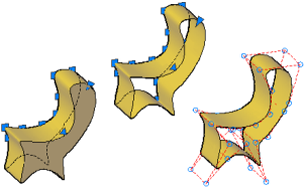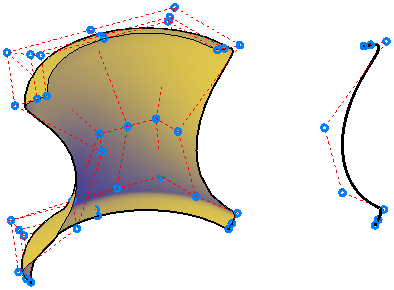You can construct solids and surfaces by extruding, sweeping, lofting, and revolving.
Methods for Constructing Surfaces or Solids From Other Geometry
When you extrude, sweep, loft, and revolve curves, you can create both solids and surfaces.

Open curves always create surfaces, but closed curves can create either solids or surfaces depending on certain settings.
If you select a closed curve and extrude, sweep, loft, or revolve an object, you create:
- A solid if the Mode option is set to Solid.
- A surface if the Mode option is set to Surface.
About Surfaces Based on Other Objects
The type of surface depends on additional settings. For example, you create
- A procedural surface if the SURACEMODELINGMODE system variable is set to 0.
- A NURBS surface if the SURFACEMODELINGMODE system variable is set to 1.
- An associative surface if the SURFACEASSOCIATIVITY system variable is on.
In this illustration, the same profile creates a solid (left), a procedural surface (middle), and a NURBS surface (right).

About Solids Based on Other Objects
You can also create 3D solids from 2D geometry or other 3D objects. For example, a 3D solid can also be the result of extruding a 2D shape to follow a specified path in 3D space.

The following methods are available:
- Sweep. Extends a 2D object along a path.
- Extrusion. Extends the shape of a 2D object in a perpendicular direction into 3D space.
- Revolve. Sweeps a 2D object around an axis.
- Loft. Extends the contours of a shape between one or more open or closed objects.
- Slice. Divides a solid object into two separate 3D objects.
- Sculpting Surfaces. Converts and trims a group of surfaces that enclose a watertight area into a solid.
- Conversion. Converts mesh objects and planar objects with thickness into solids and surfaces.
Geometry That Can Be Used As Profiles and Guide Curves
The curves that you use as profile and guide curves when you extrude, sweep, loft, and revolve can be:
- Open or closed
- Planar or non-planar
- Solid and surface edges
- A single object (to extrude multiple lines, convert them to a single object with the JOIN command)
- A single region (to extrude multiple regions, convert them to a single object with the REGION command)
Example: Use Splines to Create 3D NURBS Surfaces
Splines are one of the many 2D object types that can be lofted, extruded, swept, and revolved to create NURBS surfaces. Other 2D objects that can be used include lines, polylines, arcs, and circles. Splines, however, are the only 2D object customized to create NURBS surfaces. Because they allow you to adjust tolerance, degree, and tangency, they are better suited than other types of 2D profiles (such as lines, polylines, and circles) for surface modeling.

Many of the same commands used with NURBS surfaces, can also be used with CV splines.
Create Associative Surfaces
Surfaces can be associative while solids cannot. If surface associativity is on when a surface is created, the surface maintains a relationship with the curve from which it is was generated (even if the curve is the subobject of another solid or surface). If the curve is reshaped, the surface profile is also updated.
Deleting the Curves that Generate the Solid or Surface
The DELOBJ system variable controls whether the curves that generate an object are automatically deleted after the solid or surface is created. However, if surface associativity is on, the DELOBJ setting is ignored and the generating curves are not deleted.